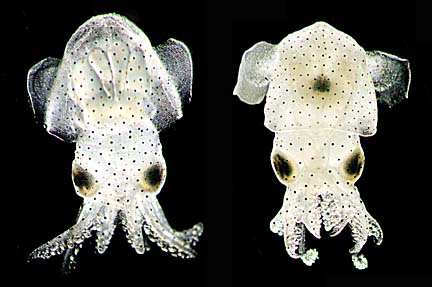
COURTESY OF HEINZ GERT DE COUET
Understanding how genes work in the Hawaiian bobtail squid could help explain how genes could have been used to create diverse life forms during evolution. Shown here are squid hatchlings, which are about 2 mm long at this stage.
Squid may help solve
evolutionary mysteryUH scientists hope to explain
the explosion of new species
about 535 million years ago
A group of normally predictable genes found in humans, fish, flies and most other animals operates differently in Hawaiian bobtail squid, researchers have discovered.
University of Hawaii-Manoa scientists and a University of Houston colleague were surprised to find that Hox genes are involved in development of a squid's unique features.
They found the genes in the animal's armlike tentacles and parts of the nervous system connected to its light-sensing organs and jet propulsion system.
Understanding how Hox genes work in a "simple" animal like squid could help explain how genes could have been used to create diverse life forms during evolution, Heinz Gert de Couet, UH zoology professor, said in an interview.
He said the bigger picture for scientists is how so many diverse animals evolved from a common ancestor.
About 570 million years ago, there were only primitive wormlike organisms, according to fossil records, he said. An explosion of diverse organisms occurred during the Cambrian Period about 35 million years later, a short time in biological-geological terms.
Scientists are drawing on genetic tools to try to explain what happened, Gert de Couet said. "Were brand-new genes invented there, essentially giving a technological leap in a biological sense? Or is it that a subset of already existing genes were just utilized in a different way?"
He said a surprising result of genome comparisons and chromosome sequencing is that "we share, as diverse animals as humans and flies, an enormous amount of genetic information."
"What this tells us is the last common ancestor of flies and worms and humans already had all the genes in common between these organisms," he said.
Hox genes are "master regulators" because they control how and where parts of the body develop, such as how many vertebrae humans have and how their faces are put together, Gert de Couet said.
They decrease or increase activity of other genes, acting as a "master switch," he said.
The UH/Houston researchers are working on a theory that new genes probably weren't involved in the Cambrian explosion, but that those already existing were used in a different way.
"We'd like to find out what was the original genetic tool kit that these organisms had at their disposal," Gert de Couet said. "What was it that suddenly enabled them to put an organism together with big eyes and eight arms instead of four?"
No one had looked at Hox genes in mollusks, so the UH/Houston researchers began cloning the genes in Hawaiian bobtail squid. They wanted to know how squids, nautiluses and octopuses, known as cephalopods, acquired characteristics not found in other mollusks.
"Compelling evidence suggests that cephalopods, with their unique modes of jet propulsion, tentacles, ink glands, light organs, cameralike eyes and profound cognitive abilities, evolved from a simple opihi-like animal," the researchers said.
Their research with the bobtail squid was "a major leap," Gert de Couet said, pointing out there are "worlds between" squid and octopus and other mollusks such as opihi, abalone and garden snails.
"It's a complex organism with phenomenal sensing organs," he said.
The scientists mapped Hox genes in squid embryos, finding them involved in nearly all of the novel characteristics of nautiluses, squids and octopuses.
"We were very surprised to find some genes almost exclusively appear in morphological novelties, something like a new invention in evolution," Gert de Couet said. "It hasn't appeared before, and all of a sudden we get this structure and no one knows where it comes from."
Investigators included Patricia Lee and Mark Q. Martindale at the UH Biomedical Research Center's Kewalo Marine Laboratory, and Patrick Callaerts of the University of Houston. Lee was lead author of a recent report on their findings in the journal Nature.
National Science Foundation grants and the UH Research Council supported the research. Lee also has a prestigious National Institutes of Health fellowship.
The researchers' next goal is to find a way to interfere with the Hox gene's function, Gert de Couet said. "To really be able to say these genes are related to morphological novelties, we need to knock this gene out or interfere with its expression and see if the organism has failed to make the structure."
